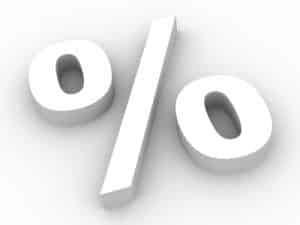SBA Loan Interest Rates Online Can Be Wrong and Confusing
SBA loan rates for the 2 largest SBA programs – the 7a and the 504 – are dependent on numerous factors and most of the information you will find when searching for anything related to current rates will reflect MUCH higher rates than actual depending on the type of loan you are looking for, how much you are looking to borrow and what you intend to do with the funds from the loan.
Do a quick Google search for any of the following terms and you will get wildly different and often incorrect answers:
- SBA loan interest rates
- SBA loan rate 2024 (or whatever year you are reading this)
- SBA 504 Loan Interest Rates
- SBA 7a Loan Interest Rate
- Etc., etc.
If this is frustrating for me, it must be frustrating for those looking for a loan.
The SBA 7a loan program in particular, is an incredibly flexible loan that can be used to fund many different business needs.
The 504 loan on the other hand, is most frequently used for larger real estate transactions of between $1 million and $20 million.
What The Search Results Show
Below are actual Google search results for the term “SBA loan interest rates” for today – July 2, 2024 – and to the right of what Google displays, I will put some notes in bold and italics with my take on what is actually accurate.
A caveat: This post is mostly about how easy it is for borrowers to get incorrect rate info for SBA loans of more than $350K. I will also omit the search results for SBA loans that are less common like an EIDL loan or the Express loan.
Anyway, the first search result on Google for today shows Google’s “AI Overview” generated by their Gemini AI product, and here is the data:
• As of July 2024, interest rates for Small Business Administration (SBA) loans vary depending on the type of loan, the amount borrowed, and the repayment terms.
This is correct.
• 7(a) variable rate: 10.75%–13.25%.
This rate may be accurate for a really small (think $50K) working capital loan for a startup business, but it is wildly incorrect for an SBA 7a loan of $350K or more for borrowers looking for the lowest interest rate on an SBA building loan, business purchase, partner buyout, etc.
For one thing, a few lenders actually offer rates below the Prime Rate, which is currently 8.5%, and many others are at or close to the Prime Rate. Even the highest priced variable rate lenders who do the hardest deals will charge a max rate of 3% over the Prime Rate, which would be 11.5% today.
• 7(a) fixed rate: 13.5%–16.5%
Again, wildly incorrect for 7a loans above $350K for real estate or business acquisition/expansions or buyouts/buyins.
Again, I am assuming these posted interest rates are for small, unsecured loans, but they are presented online as if they are the rates that all 7a borrowers can expect. Fact is, the lenders we work with that offer fixed rates have rates between the high 6’s and high 8’s at the moment. Admittedly, these lenders only fund the best transactions, but there are many good lenders offering fixed rates at 1 to 1.5% above the Prime Rate.
Also, there is no mention of what is a “fixed rate.” To most borrowers I suspect a fixed rate might mean something fixed long term like 15, 20 or 25 years, and there are definitely SBA lenders who actually offer that, but to many SBA lenders, a “fixed rate” usually means fixed for 5 years. This is not the search engines fault as I don’t believe they are capable of interpreting nuanced subjects, but suspect that Google Gemini will make this clear eventually.
• CDC/504 loan: 6.597%–7.063%
This is actually accurate for the 504 loan rate for the 2nd mortgage.
The SBA 504 program is a 2-loan structure, and the first mortgage can be almost whatever rate a lender wants to charge, but search engines and 504 lenders frequently show a 504 interest rate as if the loan is fully fixed for 25 years at this rate (the 2nd mortgage rate) without mentioning that the first mortgage could be a low fixed or a high floating rate or anything in between. Again, this rate is accurate for the 2nd mortgage, but not very helpful in light of what the blended rate and terms of both the first and second mortgage will be.
Again, I realize this is not Google’s fault and AI is not infallible, but if you look at the next 5 websites listed for the same search, you get more of the same.
For example, the #1 search result is the SBA website and here is the snippet that Google has picked up:
“Interest rates ; $50,000 or less, Base rate plus 6.5% ; $50,001 to $250,000, Base rate plus 6.0% ; $250,001 to $350,000, Base rate plus 4.5%.”
The following is only visible if you click through to the actual page of the SBA website and scroll to the section that discusses rates where it says:
“Interest rates for 7(a) loans are negotiated between the borrower and the lender, but are subject to SBA maximums, which are pegged to the prime rate or an optional peg rate. Interest rates may be fixed or variable.”
What it is NOT obvious even when reading the actual page, is the above interest rates are “maximums” meaning, they are the highest rates that lenders can charge.
Similarly, if I go over to ChatGPT and do the same search for “SBA Loan Interest Rates,” this is what is returned:
“As of July 2024, SBA loan interest rates vary depending on the loan type and amount. Here are the current rates:
SBA 7(a) Loans
- $50,000 or less: Prime + 6.5% (maximum 15.0%)
- $50,001 to $250,000: Prime + 4.5% (maximum 14.5%)
- $250,001 to $350,000: Prime + 4.0% (maximum 13.0%)
- More than $350,000: Prime + 3.0% (maximum 11.5%)
The current Prime Rate is 8.5%”
Again, just as above using Google, this wildly misrespresents what SBA loan interest rates actually are, as to read the above, you would be led to believe that the “current rate” for an SBA 7a loan of $350,000 or more is Prime + 3% and this is WRONG.
Prime + 3% is a worst-case scenario and is the highest rate the SBA allows a lender to charge a borrower, and yet here and many other places online, it is shown as the “current SBA loan rate.”
This is unfortunate and confusing – especially when you consider that a hefty percentage of SBA 7a loans are closed at a rate of between Prime and Prime + 1.5% – which is 8.5% to 10% at the moment.
This is due to the fact that most SBA loans are of “good to very good” quality, and there are numerous lenders who coincidentally offer “good to very good pricing.”
You will notice that 8.5% to 10% is WAY, WAY below the interest rates presented in the aforementioned Google and ChatGPT searches and this does not account for the loans that are closed below (sometimes way below) the Prime Rate.
And this is a problem.
Why High Interest Rate Lenders Actually Have a Place in the Market
I do feel like I need to address when a high rate lender is the right solution for a borrower. Not “crazy high” like above, but higher than what I have discussed so far.
There are actually many lenders who only charge at or close to Prime +3% for all of their 7a loans as it is their business model, and this is capitalism we are talking about, so it is not like they are not allowed to charge the maximum rate.
There is a method to why they do this however…
Typically, these lenders are what are known as “secondary market lenders” who sell the SBA Guaranty for profit and the higher the rate they sell, the more they make, so naturally they try to sell that rate to everyone.
However, as odd as it sounds, these lenders are somewhat indispensable in the marketplace and they do a lot of business as there is a very real need for their services to do loans for borrowers who cannot qualify with more conservative, lower interest rate lenders.
More conservative lenders are typically unwilling to help borrowers who do not have “easy” or relatively easy loans and these “high-rate” lenders frequently step up and get the job done.
As an example, we recently received a commitment from one of our high rate SBA 7a lenders for a $2 million business acquisition transaction that multiple previous lenders turned down. It is a purchase of a business where the cash flow is good, the borrower does not have any experience in the industry (but currently owns another successful business), has good credit, some liquidity/reserves and equity in a few properties.
All of these qualities (or lack thereof) are enough to have most conservative lenders take a pass, but what really turned off some of our lower rate lenders is the lack of down payment coming from the borrower, as we have structured this deal with NO down payment from the borrower. This is possible, because the seller (who is going to stay on for a year) is willing to hold a note for 10% of the purchase price on “full standby” for 24 months.
SBA Guideline Tip: Seller-held notes on “full standby” can be considered just like cash down payment for a borrower – you can read up on how it works on our full standby seller note page. This is one of the hyper-flexible features of the SBA 7a loan, and it is helping get lots of loans closed for borrowers who do not want to part with a 10% down payment, but many conservative low-rate lenders won’t allow it.
This loan is approved, but the catch for the borrower is that she is having to accept an interest rate of Prime +2.5%, which is 11% today. The silver lining however, is that she can refinance in 2 years with a 1% penalty or after 3 years with no penalty.
FYI: the reason she has a minimal penalty if she refinances in the first few years, is because she is also purchasing real estate as part of the acquisition and it accounts for slightly more than 51% of the proceeds of the loan. Had she been purchasing just the business, there would be no penalty to refinance.
And the possibly irony there, is that she will probably end up doing that with one of the more conservative SBA 7a lenders who do not peg their interest rates to the Prime Rate – and who would not do the loan now – but will be happy to work with her once she has a long enough track record of operating the business successfully.
This “SBA to SBA” refinance is possible because the SBA recently changed their guidelines to allow borrowers to refinance an SBA 7a loan with another SBA 7a loan, which can make a tremendous amount of sense for a borrower to take advantage of even if rates do not drop over the next few years.
Think about it…if a borrower has to settle for something like Prime + 2.5% today (11%), but they do well enough with the business over the next 2 to 3 years and have the tax returns to prove it, then even if rates have not moved, there should be numerous non-Prime Rate-based lenders whose rates are currently around 7% (and should be in the future as well) who would be happy to refinance a business with a proven operator at a future rate that could be 2, 3 or maybe even 4% lower than 11%.
Pretty brilliant, huh?
Anyway, the above example is why these higher rate lenders are needed, because they serve as a bridge lender of sorts, and they get the hard, but approvable deals done and the money they make in the secondary market helps offset the additional risk they are taking and the system works.
But the crazy thing is that even at Prime plus 2.5% to Prime plus 3%, these rates are nowhere near as high as the interest rates shown above when using the most searched for terms for SBA loan rates.
So the big disconnect is that a web search for “SBA loan interest rates” shows seemingly authoritative websites or “trusted” AI engines displaying the highest possible rate as the going rate, and this is again, unfortunate, as many current or prospective small business owners might get discouraged by the high rates that they see or settle for working with a lender offering a rate that is way higher than what they may be able to get with a little more looking.
End of rant 😉


